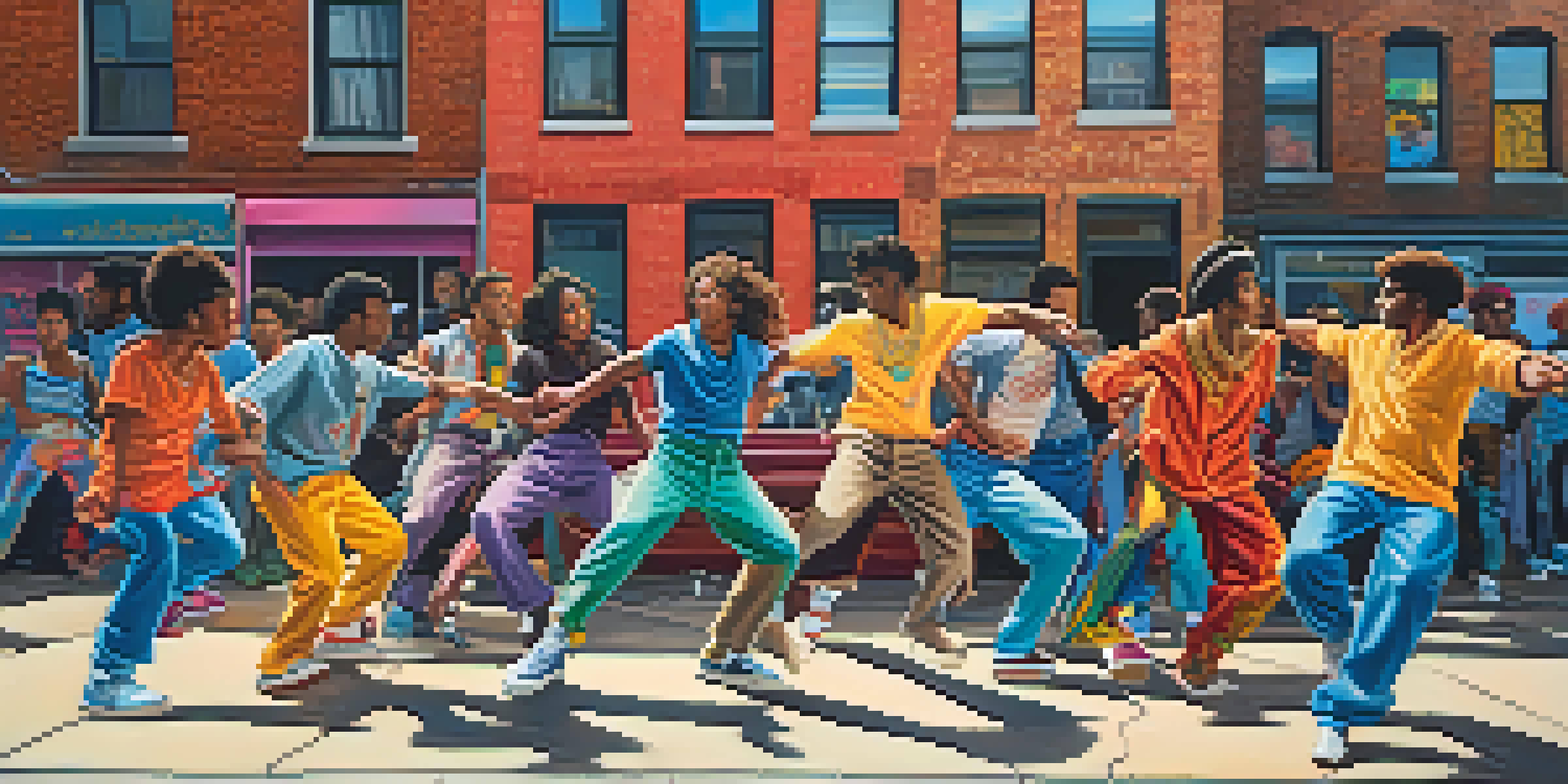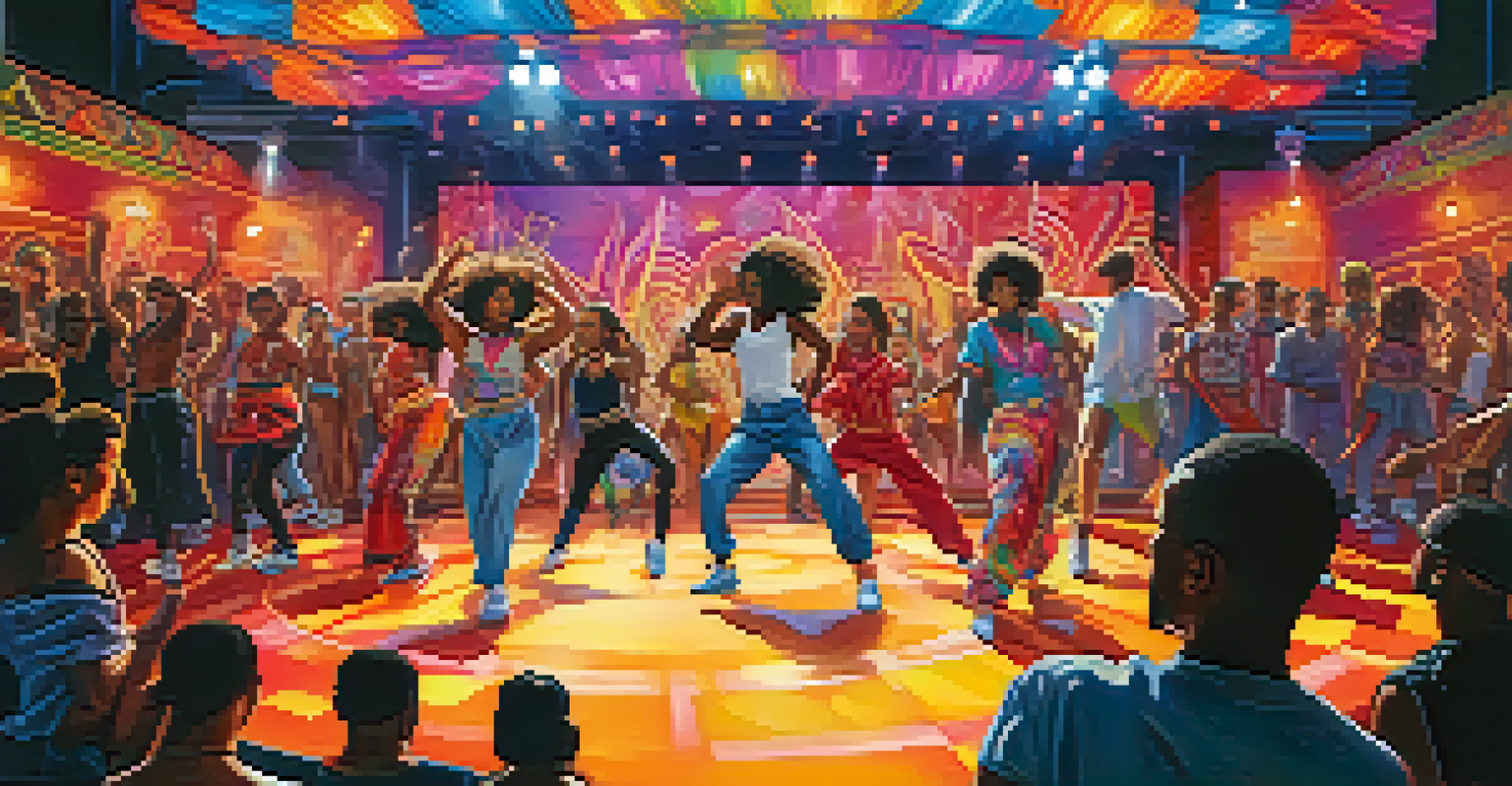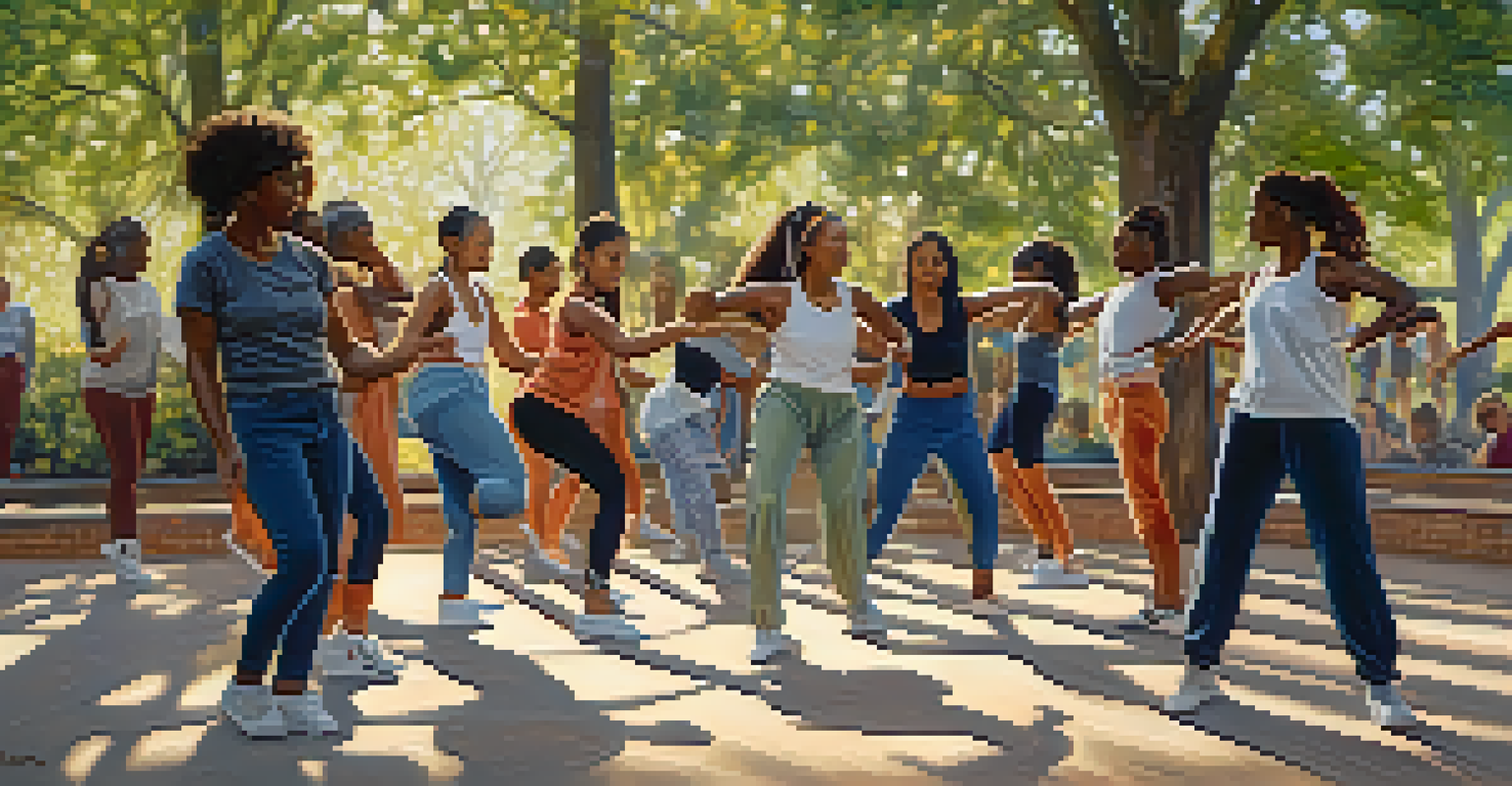The Fusion of Hip-Hop and Traditional Dance Styles Across Cultures

Understanding Hip-Hop: A Cultural Movement
Hip-hop originated in the 1970s in the Bronx, New York, as a vibrant expression of urban culture. It encompasses not just music but also dance, fashion, and visual arts. The dance forms associated with hip-hop, like breakdancing, are rooted in improvisation and storytelling, reflecting the experiences of the community. Understanding hip-hop's cultural background is essential to appreciate its ongoing evolution and fusion with other dance styles.
Dance is the hidden language of the soul.
As hip-hop gained popularity, it began to spread beyond the streets of New York, influencing various art forms globally. This global influence has led to a rich tapestry of dance styles merging with hip-hop. Traditional dances from different cultures, such as African, Indian, and Latin American, have found their way into hip-hop choreography, creating a unique blend of rhythms and movements.
This fusion not only enriches hip-hop but also honors the history and heritage of the traditional styles involved. By integrating these diverse elements, dancers are able to tell stories that resonate on a deeper level, bridging cultural gaps and fostering a sense of community through shared artistic expression.
Traditional Dance: A Window into Cultural Heritage
Traditional dance serves as a vital expression of cultural identity and history. Each dance style comes with its own set of movements, music, and significance, often passed down through generations. Whether it’s the graceful movements of ballet or the rhythmic steps of African dance, these forms convey stories and emotions that are deeply rooted in their respective cultures. They often celebrate life events, rituals, and social gatherings, enriching the community's cultural fabric.

As hip-hop artists and dancers explore these traditional styles, they not only gain new techniques but also insights into the cultural significance behind the movements. This exploration can lead to a deeper appreciation of the origins and meanings of these dances. For example, when hip-hop dancers incorporate elements of Indian classical dance, they might not only learn new steps but also gain an understanding of the spiritual narratives that inform those movements.
Hip-Hop's Cultural Evolution
Hip-hop's fusion with traditional dance styles enriches its narrative and fosters cultural appreciation.
This connection creates a dialogue between the past and the present, allowing for a vibrant exchange of ideas and styles. It reveals how dance can serve as a universal language, transcending borders and fostering connections among diverse communities.
Global Influences: The Cross-Cultural Dance Scene
The fusion of hip-hop and traditional dance isn't confined to one geographical location; it's a global phenomenon. Different regions have their own unique dance styles that have begun to blend with hip-hop, showcasing the versatility of both genres. In Brazil, for instance, Brazilian funk and hip-hop have come together, creating energetic dance moves that captivate audiences worldwide. Such cross-cultural fusions highlight the adaptability and appeal of hip-hop as a universal art form.
Hip-hop is a way of life. It's a culture that has a lot of different elements to it.
In addition to Brazil, countries like Japan and South Africa have also embraced this fusion. Japanese street dancers often incorporate elements of traditional kabuki, while South African dancers blend hip-hop with indigenous styles like gumboot dancing. These collaborations not only enhance the visual spectacle but also keep traditional dance alive in contemporary settings, ensuring that cultural heritage continues to be celebrated.
This global exchange enriches both hip-hop and traditional dance, promoting a sense of unity among diverse cultures. By dancing together, artists from various backgrounds create a shared space where cultural appreciation thrives, encouraging audiences to engage with and learn from different traditions.
The Role of Dance Competitions and Festivals
Dance competitions and festivals play a crucial role in showcasing the fusion of hip-hop and traditional dance styles. Events like World of Dance and various cultural festivals provide platforms for dancers to demonstrate their unique fusions. These gatherings not only highlight individual talent but also celebrate the creativity that arises when different styles intersect. Competitors often push the boundaries of their art, experimenting with new ways to incorporate traditional elements into their hip-hop routines.
Moreover, these competitions foster a sense of community among dancers. Participants often share techniques and ideas, learning from one another in a supportive environment. This collaborative spirit is essential for the continued evolution of dance as it encourages innovation and experimentation. For many, these competitions also serve as a stepping stone to larger platforms, helping dancers gain recognition in the broader dance community.
Global Dance Collaborations
The blending of hip-hop with diverse traditional dances worldwide promotes unity and creativity among cultures.
The exposure gained from these events can inspire other dancers to explore the fusion of hip-hop with their own cultural backgrounds. As more artists embrace this idea, the landscape of dance continues to expand, leading to exciting and unexpected combinations that keep the art form fresh and engaging.
Social Media: Amplifying Dance Fusions
In today's digital age, social media plays a pivotal role in amplifying the fusion of hip-hop and traditional dance. Platforms like Instagram, TikTok, and YouTube allow dancers to showcase their work to a global audience, breaking geographical barriers. This visibility has led to viral trends that often incorporate traditional dance elements into popular hip-hop routines, encouraging others to experiment with their own cultural styles. The ability to share and learn from one another has never been easier.
Social media also creates a sense of accountability among dancers, motivating them to continuously improve and innovate. By watching and engaging with fellow dancers worldwide, artists can draw inspiration from various styles, leading to exciting new fusions. For instance, a dancer in New York might be inspired by a video of a traditional African dance, incorporating its movements into a hip-hop routine that resonates with their own experiences.
Furthermore, social media serves as a platform for discussions about cultural appropriation and appreciation. As dancers navigate the complex dynamics of blending styles, they are encouraged to approach their art with respect and understanding. This awareness fosters a culture of sensitivity and appreciation, ensuring that the fusion of hip-hop and traditional dance remains a celebration of diversity.
The Impact of Education and Workshops
Education and workshops play a significant role in fostering a deeper understanding of both hip-hop and traditional dance styles. Many dance studios and community centers offer classes that highlight the importance of cultural context when learning new styles. These workshops often feature experienced instructors who share their knowledge about the history and significance of the dances, ensuring that students appreciate the roots of what they are learning. This educational approach helps cultivate a sense of respect for traditional forms while encouraging creativity.
Through these classes, dancers can experiment with fusing hip-hop with traditional movements, allowing for a hands-on experience that enhances their skills. For example, a hip-hop dancer may take a workshop in traditional African dance, discovering new ways to incorporate those fluid movements into their routines. This experiential learning not only broadens their technical abilities but also deepens their cultural understanding.
Impact of Education on Dance
Educational workshops enhance dancers' skills while deepening their understanding and respect for cultural roots.
Moreover, educational institutions are increasingly recognizing the value of interdisciplinary studies in dance. By offering courses that explore the intersections of various dance styles, schools are preparing the next generation of dancers to be both versatile and culturally aware. This commitment to education ensures that the fusion of hip-hop and traditional dance continues to evolve while honoring its diverse roots.
Celebrating the Future of Dance Fusion
The fusion of hip-hop and traditional dance styles represents a dynamic and evolving art form that celebrates cultural diversity. As more dancers and choreographers explore these fusions, new trends and styles emerge, enriching the dance community as a whole. This ongoing exploration not only highlights the adaptability of hip-hop but also rejuvenates traditional dances, bringing them into contemporary contexts where they can thrive. The future of dance fusion looks promising as artists continue to push boundaries and experiment with their craft.
This celebration of diversity is not merely about merging movements; it’s about storytelling and connection. Each dance performance becomes a narrative that reflects the artist's background and experiences, inviting audiences to engage with different cultures. By showcasing these unique blends, dancers help foster a greater understanding and appreciation for cultural differences, promoting unity through art.

Ultimately, the fusion of hip-hop and traditional dance styles invites everyone to participate in a global dialogue through movement. As artists continue to innovate and collaborate, we witness the emergence of fresh perspectives and exciting new forms of expression, ensuring that the world of dance remains vibrant and accessible for generations to come.